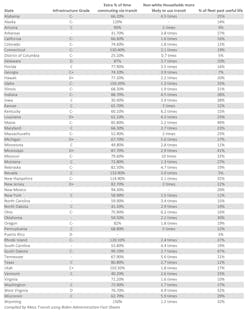Biden Administration makes case for American Jobs Plan with state fact sheets
The Biden Administration released a series of fact sheets for each of the 50 states, as well as the District of Columbia and Puerto Rico, as part of its push to deliver on the proposed American Jobs Plan.
The Biden Administration highlights the increased percentage of time state residents spend commuting by public transit, how likely non-White households are to commute via public transit and the percentage of a state’s transit fleet that is past the useful life.
The American Jobs Plan includes a proposed $85 billion for direct transit investment and $80 billion for Amtrak within the plan’s $621 billion transportation investment proposal.
According to the White House, the American Jobs Plan aims to fix “crumbling transportation infrastructure” and make significant strides against the $105-billion repair backlog the U.S. Department of Transportation estimates exists.
According to the fact sheets, the states with the highest percentage of their transit fleet beyond its useful life:
- Maine – 49%
- South Dakota – 47%
- Mississippi – 41%
- Indiana – 38 %
- Iowa – 38%
The Biden Administration argues the significant backlog of transit repair results in service delays and disruptions that “leave riders stranded and discourage transit use.” The administration is trying to make the case that by investing in expanded systems, rider demand can be met, which will “ultimately reduce traffic congestion for everyone.”
According to the fact sheets, the states with residents who spend the most additional time commuting via public transit:
- Idaho – 150.2%
- Wyoming – 150%
- Nevada – 133.9%
- Connecticut 130.4%
- Rhode Island – 120.1%
A key to the administration’s proposal is advancing racial justice by providing a more equitable transportation network, which includes public systems. The administration explains Asian American and African American workers commute by public transit at nearly four times the rate of white workers. The administration’s goal is to increase transit access to communities of color, as well as “the economic opportunity that equitable transit systems unlock.”
States with highest occurrence of non-White households commuting by public transit:
- Ohio – 6.2 times more
- Kentucky – 6.2 times more
- Wisconsin – 5.9 times more
- Tennessee – 5.6 times more
- Michigan – 5.6 times more
---------
Editor’s note: There are caveats to the information presented in the fact sheets. The Biden Administration did not make it clear from where the fact sheets’ information was sourced. The percentage of transit fleets beyond their useful life matches the most recent National Transit Database information. But the metric quantifying how much extra time state residents spend commuting via public transit does not indicate what that commute is being compared against. State residents who do not commute? State residents who commute using their own vehicle?
About the Author

Mischa Wanek-Libman
Group Editorial Director
Mischa Wanek-Libman is director of communications with Transdev North America. She has more than 20 years of experience working in the transportation industry covering construction projects, engineering challenges, transit and rail operations and best practices.
Wanek-Libman has held top editorial positions at freight rail and public transportation business-to-business publications including as editor-in-chief and editorial director of Mass Transit from 2018-2024. She has been recognized for editorial excellence through her individual work, as well as for collaborative content.
She is an active member of the American Public Transportation Association's Marketing and Communications Committee and served 14 years as a Board Observer on the National Railroad Construction and Maintenance Association (NRC) Board of Directors.
She is a graduate of Drake University in Des Moines, Iowa, where she earned a Bachelor of Arts degree in Journalism and Mass Communication.

